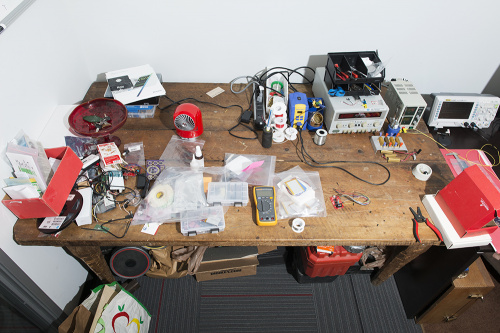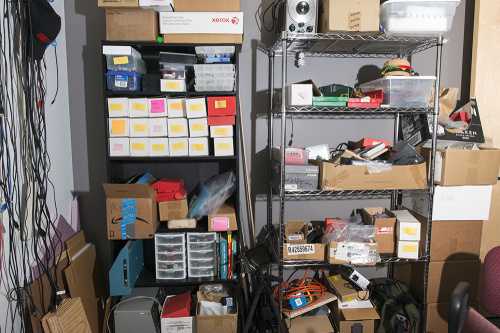We're back with more desk details! In case you need a refresher, this is Part 2 in a new series where we barge in on our engineers while they’re working and kick them out so we can document their desks in all their chaotic glory. And because we know that just isn’t enough information, we ransom their offices back to them in exchange for some details on what they have on their desks and why. We do this for you!
Clicking the image will enlarge it, so you can experience the full resolution of each engineer’s home away from home.
Today's victim is Marshall! Let's see what he has to say.
This is a three-parter; let's start with my design area.
A lot of engineering work is done behind the computer. In order to make a thing, a plan must be made; all the parts selected, checked and rechecked; design parameters calculated; and theories ironed out. And, of course, CAD drawings must be created for production. On top of that, any firmware needed is created at a computer, so I sadly spend most of my time here, at my design desk. I basically have three different piles here, and though it looks chaotic --- what with the scope probes and circuits and all --- there is a system.
Left side: Stack of folders containing design documents that are currently in progress. Usually the one I'm working on today is open, or pulled out. When a product is done, these go into my filing drawer.
Behind the keyboard: Prototypes and specific test hardware for the projects in the folders. Here you can see some purple LilyPad boards, and a rat's nest of red, which is the same circuit but built up to test pin locations and to write board files for Arduino before the hardware is manufactured. This hardware tends to end up in the junk pile when the folders are archived.
Right side: Aside from office supplies, these are circuits that generally have to stay here despite my desire to not have them. They are RedBoards, ESPs, Teensys and other microcontrollers that I need randomly from day to day. The best feature here is really the clip that is holding the cardboard. Those pots are used to supply test data while writing code, and the clip holds the USB cables I'm currently using, which prevents them from dragging the attached targets to the floor.
The scope probably belongs on the bench, but I've decided to put it off to the left because I find I use it while computing and need to scope serial signals and timing loops, but also when experimenting on my bench to debug analog circuits.
Let's move on to my test bench!
The test bench is a real mixed bag. I use it for light soldering (we have communal benches that are better for soldering), building fun projects and, most importantly, to set up tests.
The things that constantly stay on the bench are mostly in the upper right-hand corner: a couple of power supplies for three variable voltages plus 5V, soldering iron and supplies, and a mix of wires. Also, the fan is useful to get fumes away from my face, and a candy dish to contain things I must absolutely not misplace.
The rest of the stuff gets used, soldered, chopped, dismembered and eventually pushed over to the left side, where it sits until the pile gets too big (it's too big now) and is filed back into inventory.
The bench itself is an interesting thing, rough-hewn probably a hundred years ago by some farmer. The ownership is subject to dispute because anyone who owns it eventually says it's too big to move, so they give it away but want it back someday when they have a place for it. So here it sits.
Next up: inventory.
Storage is a problem that every maker must face. We want to keep everything, but don't have room. My method is this bookshelf and wire rack. The bookshelf holds individual components (and a couple of books!), while the wire rack holds tools and things used for testing.
On the bookshelf, from top to bottom, I've got:
Components: Dev boards, subassemblies (parts of panels, collections of sliders, SMD component trays, PCBs, boxed components such as resistors, silicon, gauges, terminal blocks, etc.), then below bag storage, hookup wires, misc. mechanical parts, enclosures and hardware like nuts and bolts. Basically, anything that has no specific purpose lives on the bookshelf.
Tools: The wire rack, from top to bottom, has a sine generator, more wires, power resistors, hand tools, measuring things (distance), test leads, discrete, cap, resistor kits, a box of multimeters, misc. apparatus, thermometers, more test leads, known good SFE product, banana jacks, line switches and transformers, and a tackle bag I use for putting my scope in when I'm on the go.
Off to the left, you can see even more test leads (I think there's a theme here) and storage for flat materials.
That's it!
Thanks, Marshall! Leave any questions in the comments, and stay tuned for the next "Desk of an Engineer."









Is that a Grandstream IP phone I see? Really?!
Is that what that is? Sometimes it rings when the burrito truck is outside. We're really not big enough that a phone system is super useful.
You didn't discuss the elephant in the room: what's that calculator in front of your keyboard? And why do you prefer that over having a calculator (or Python or something) running on your computer?
That's the TI92, which is the same os and feel as the ti89 hidden in my desk drawer. My friend said, "I have this old TI92 that was required for a course but I was going to throw it out if you don't want it." Um... yes!
The irony is that I basically use it as a 4 function. I use the computer for binary/programming calculations as well as anything that involves graphs. It's a fun desk piece though, really makes people think I know what I'm doing.
This is a very interesting series to those of us who admire the SF Engineering staff... Mary's pegboard is desktop genius... The Mary edition was also great because I happen to be in the market for an oscilloscope and am curious about the actual models of oscopes used by real EEs at Sparkfun...what does Marshall use?
Hey! I use the rigol ds1054z I basically selected for the price... and the ability to upgrade it.
My two favorite features are the ability to save screenshots to USB, and the ability to decode serial data live. The serial decoder is a bit buggy, but it's pretty helpful.
I bought this one personally, and wanted 4 channels at above 100MHz, and bought the cheapest one that had good reviews. Sometimes 2 channel scopes can be attractively priced, but if you need a real scope with two channels, chances are you'll need 4 soon.
My favorite scope so far is the Tek 4000 series with active probes... I just don't have that kind of money!
Good luck on your search
Good info- I like the price too, but I wasn't sure it had the capability I would need as a hobbyist. If it works for you, it will definitely work for me... thank you Marshall!